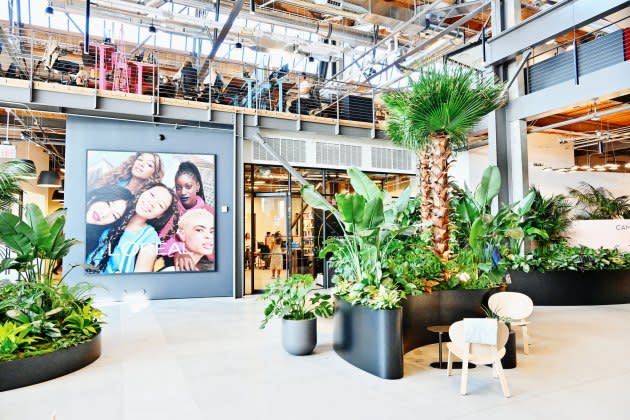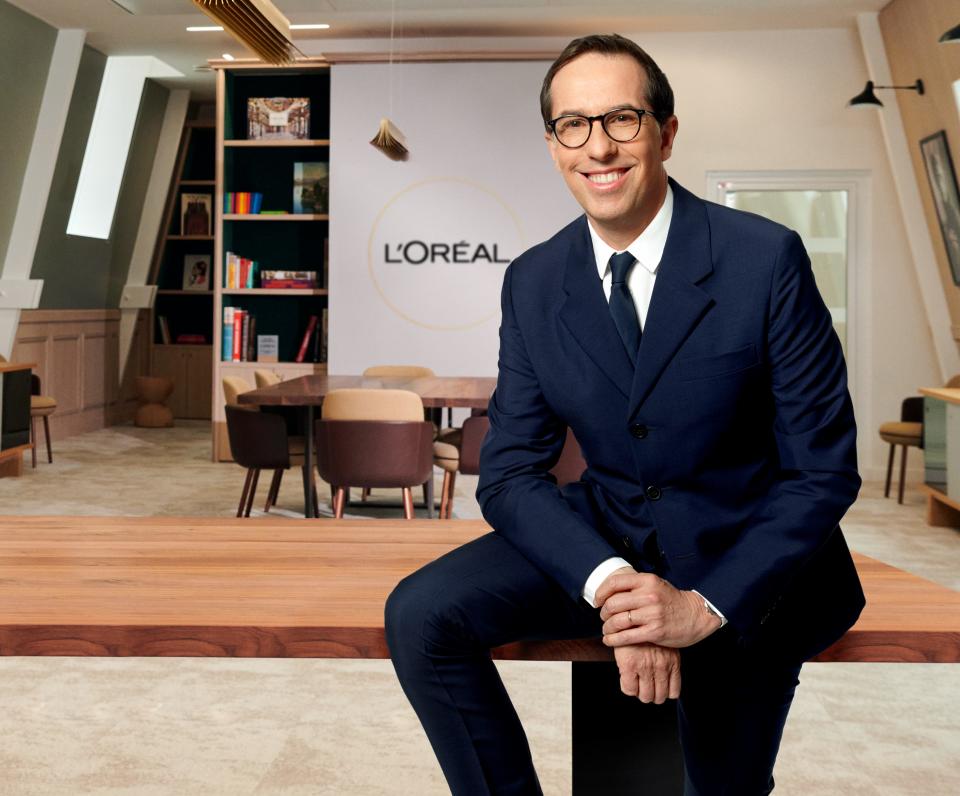L’Oréal CEO Talks Beauty Market Dynamism

PARIS — The beauty market is expected to continue full steam ahead after a strong first half of 2023, when it registered double-digit growth, despite inflationary pressures.
That was the outlook shared by Nicolas Hieronimus, L’Oréal chief executive officer, while addressing financial analysts and journalists Friday morning, a day after the company released its second-quarter and half-year results.
More from WWD
Should You Buy a Dyson Airwrap Dupe? Here's Everything You Need to Know.
Maybelline New York Launches Virtual Beauty Looks on Microsoft Teams
During the discussion, he drilled down on developments in China — where there’s been a slowdown in Hainan Island’s duty-free trade, offline and online evolutions, as well as financial milestones hit by the group.
As previously reported, in the six months ended June 30 company net profits grew 4.3 percent to 3.36 billion euros on sales of 20.57 billion euros, up 12 percent in reported terms and 13.3 percent like-for-like. That marked the first time group sales exceeded 20 billion euros in a half-yearly period.
Operating margin came in at 20.7 percent, an increase of 30 basis points, setting another company record, while earnings per share excluding non-recurrent items gained 11.2 percent to 6.73 euros.
During the period, skin care generated 41 percent of overall L’Oréal sales, at 8.5 billion euros, up 14.6 percent on-year. Makeup was the next largest category, comprising 20 percent of the total and notching an 11.1 percent gain. Hair care made up 15.8 percent of sales, fragrance, 11 percent, and hair color, 8 percent. Those categories’ sales grew 15.8 percent, 21.8 percent and 7.2 percent, respectively.
“In an environment still marked by considerable inflationary pressures around the world, our growth was driven by a strong contribution from volume, up 4.9 percent, and value, up 8.5 percent,” Hieronimus said. “We estimate that the beauty market grew by close to 10 percent in the first half, so we outperformed again, which is obviously fantastic news.
“But what makes me especially proud is that this comes after not one, but two years of exceptionally strong share gains,” he continued.
Hieronimus said both retail channels — offline and online — were dynamic. He noted brick-and-mortar staged a strong comeback. In that channel, L’Oréal sales grew 13.8 percent, versus the market’s sales that increased about 9 percent. L’Oréal’s e-commerce sales were up 12.1 percent against the market’s approximate 11 percent rise.
Hieronimus underscored the group’s balanced geographical footprint by revealing the top-five growth contributors by country were the U.S.; China; the Germany, Austria and Switzerland cluster; France, and Mexico.
“[They] represent each one of our regions,” he said.

In the half, sales in North Asia were up 3.9 percent on a comparable basis, after an acceleration in the second quarter, when they rose 5.9 percent versus plus-1.9 percent in the first quarter.
Herionimus described the second-half performance there as having many moving parts. “Most of them [are] linked to what we call the Chinese consumption ecosystem, which includes notably mainland China, Hainan and Hong Kong — three markets between which consumption is becoming increasingly fluid,” he said.
“In mainland China, we are seeing clear signs that consumption is recovering,” he said. “Consumer confidence is improving, restaurants are full, local travel is resuming. The recovery has been a bit slower than expected, but let’s be honest — three years of COVID-19 will take a bit of time to be fully digested.
“Appetite for beauty remained strong — both offline and online,” Hieronimus continued. “In the second quarter, beauty growth recovered to plus-6.5 percent.”
That’s against negative growth in the first quarter.
“And how did we do? Our growth accelerated strongly, from broadly flat in the first quarter to mid-teens in the second quarter,” the executive said, explaining L’Oréal innovations resonated well, the group introduced brands such as Valentino, Prada and Takami, and entered lower-tier cities.
“We significantly outperformed the market and continued to gain share,” he said, adding that further cemented L’Oréal’s clear leadership position.
“We had a very successful 618,” said Hieronimus, referring to the key shopping festival in China. “Lancôme and L’Oréal Paris were the number-one and -two brands, and we had another six brands in the top 20. I want to highlight that our growth outside 618 was equally strong, signaling that the market is gradually getting back to normal.
“In Hainan, however, there’s been a clear deterioration between the first and the second quarter,” he said, about the Chinese island that became a duty-free shopping having during the pandemic. “In mid-May, the authorities started to exercise much tighter control over the Daigou trade to preserve what they call ‘Hainan’s golden brands.’”
Daigou is an informal cross-border market trade involving people buying products abroad to then resell them in China at a higher price.
“Travel-retail operators have consequently refocused on the individual traveler,” Hieronimus said. “This has had a severe impact on industry-wide sellouts. We are obviously not immune to this. We estimate that if the current policy remains the same, it could lead to a couple of months of inventory reduction, keeping in mind that our absolute priority is the protection of our brands’ equity within the Chinese ecosystem.
“To put our exposure into context, Hianan represents less than 3 percent of our business — the total Chinese ecosystem, around 23 percent,” he said. “So mainland China has always been our focus, and we believe that the new paradigm in Hainan should have a positive impact on sellouts in the domestic market. This plays in our favor, given how strong our market share is in mainland China.”
On Douyin recently, there’s already been noted a partial transfer of purchases to the domestic Chinese market.
“All in all, our first-half sell-through in the Chinese ecosystem amounted to plus-10 percent,” Hieronimus said. That was well ahead of a market that had a 2.6 percent increase.
He said in the first half, L’Oréal growth engines fired on all cylinders and that its virtual circle was in full swing.
“Of course, we can’t deny that we are facing a few headwinds for the second half,” he said.
Currency exchanges are expected to be less favorable, there is the Hainan effect and the fact that price is to make a smaller contribution to the total value growth.
“Despite that, we are very confident in our ability to maintain very good momentum in the second half,” Hieronimus said.
There are five main reasons for this. First, L’Oréal believes consumer demand for beauty will remain robust. Hieronimus discussed the strength of markets in the first half.
“And as we’re entering the second half, we do not see any sign of downtrading in the western world,” he said. “Emerging regions remain equally dynamic.”
Consumer interest is high, according to online search queries. In the half, Google searches for beauty topics rose 14 percent — with those for fragrance up 26 percent — and beauty was the number-one topic on TikTok.
Second, L’Oréal’s 36 international brands have strong innovation in the pipeline for the second half.
“They will all come with strong valorization,” Hieronimus said. “Third, we continue to reinforce our digital leadership, which has always contributed to our outperformance.”
He said L’Oréal is the global number-one in beauty share of influence, with 26.4 percent, up 5 points versus 2022. The group is, as well, the first mover on TikTok in China and the western world.
The fourth reason for the company’s confidence is that the group remains true to its research-and-innovation roots, and the fifth cause is L’Oréal’s engaged teams, according to Hieronimus.
He said company’s acquisition of Australian beauty brand Aesop is expected to be completed in the second half of this year, and that the first-time consolidation should have an estimated dilutive impact of around 25 basis points on the group’s operating margin on a 12-month running basis.
“Despite the remaining uncertainties of the economic landscape, we are confident that we will deliver another very good performance in the second half,” Hieronimus said.
“We look beyond 2023 with great conviction. We operate in an incredibly dynamic market. We have created for ourselves an unrivaled well-balanced footprint by category, channel or region,” he said. “It is this balance that has allowed us to weather turbulences in our industry many times over. Our virtuous P&L will continue to fuel our growth, while helping us to improve our margins.”
Best of WWD

